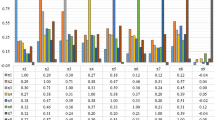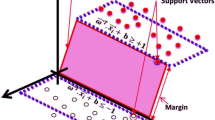Abstract
This paper presents the use of multiclass support vector machines (SVMs) for diagnosis of spirometric patterns (normal, restrictive, obstructive). The SVM decisions were fused using the error correcting output codes (ECOC). The multiclass SVM with the ECOC was trained on three spirometric parameters (forced expiratory volume in 1s—FEV1, forced vital capacity—FVC and FEV1/FVC ratio). The total classification accuracy of the SVM is 97.32%. The obtained results confirmed the validity of the SVMs to help in clinical decision-making.





Similar content being viewed by others
References
Crapo, R. O., Pulmonary-function testing. N. Engl. J. Med. 331:25–30, 1994. doi:10.1056/NEJM199407073310107.
Ferguson, G. T., Enright, P. L., Buist, A. S., et al., Office spirometry for lung health assessment in adults: a consensus statement from the National Lung Health Education Program. Chest. 117:1146–1161, 2000. doi:10.1378/chest.117.4.1146.
Vandevoorde, J., Verbanck, S., Schuermans, D., Kartounian, J., and Vincken, W., FEV1/FEV6 and FEV6 as an alternative for FEV1/FVC and FVC in the spirometric detection of airway obstruction and restriction. Chest. 127 (5)1560–1564, 2005. doi:10.1378/chest.127.5.1560.
Vandevoorde, J., Verbanck, S., Gijssels, L., Schuermans, D., Devroey, D., De Backer, J., Kartounian, J., and Vincken, W., Early detection of COPD: a case finding study in general practice. Respir. Med. 101 (3)525–530, 2007. doi:10.1016/j.rmed.2006.06.027.
Aaron, S. D., Dales, R. E., and Cardinal, P., How accurate is spirometry at predicting restrictive pulmonary impairment? Chest. 115 (3)869–873, 1999. doi:10.1378/chest.115.3.869.
Global Strategy for Asthma Management and Prevention 2006. The Global Initiative for Asthma 2006. http://www.ginasthma.com/GuidelinesResources. asp; accessed 7 November 2007.
Christine, A., Glady, M. D., Shawn, D., and Aaron, M. D., Mary Lunau, MSc., Jennifer Clinch, M.A., Robert, E., Dales, M.D., A spirometry-based algorithm to direct lung function testing in the pulmonary function laboratory. Chest. 123:1939–1946, 2003. doi:10.1378/chest.123.6.1939.
Übeyli, E. D., Comparison of different classification algorithms in clinical decision-making. Exp. Syst. 24 (1)17–31, 2007. doi:10.1111/j.1468-0394.2007.00418.x.
Übeyli, E. D., Analysis of EEG signals by combining eigenvector methods and multiclass support vector machines. Comput. Biol. Med. 38 (1)14–22, 2008. doi:10.1016/j.compbiomed.2007.07.004.
Übeyli, E. D., Combining neural network models for automated diagnostic systems. J. Med. Syst. 30 (6)483–488, 2006. doi:10.1007/s10916-006-9034-z.
Übeyli, E. D., A mixture of experts network structure for breast cancer diagnosis. J. Med. Syst. 29 (5)569–579, 2005. doi:10.1007/s10916-005-6112-6.
Übeyli, E. D., Multiclass support vector machines for diagnosis of erythemato-squamous diseases. Exp. Syst. Appl. 35 (4)1733–1740, 2008. doi:10.1016/j.eswa.2007.08.067.
Übeyli, E. D.: Modified mixture of experts for diabetes diagnosis. J. Med. Syst., 2009, (in press).
Übeyli, E. D.: Adaptive neuro-fuzzy inference systems for automatic detection of breast cancer. J. Med. Syst., 2009, (in press).
Übeyli, E. D., and Doğdu, E.: Automatic detection of erythemato-squamous diseases using k-means clustering. J. Med. Syst., 2009, (in press).
Übeyli, E. D., İlbay, K., İlbay, G., Sahin, D., and Akansel, G.: Differentiation of two subtypes of adult hydrocephalus by mixture of experts. J. Med. Syst., 2009, (in press).
Vapnik, V., The Nature of Statistical Learning Theory. Springer, New York, 1995.
Quanjer, P. H., Tammeling, G. J., Cotes, J. E., et al., Standardized lung function testing: lung volumes and forced ventilatory flows. Eur. Respir. J. 6 (suppl)5s–40s, 1993.
Knudson, R., Lebowitz, M., Holberg, C., et al., Changes in the normal maximal expiratory flow-volume curve with growth and aging. Am. Rev. Respir. Dis. 127:725–734, 1983.
Fishwick, D., Bradshaw, L. M., D’Souza, W., Town, I., Armstrong, R., Pearce, N., and Crane, J., Chronic bronchitis, shortness of breath, and airway obstruction by occupation in New Zealand. Am. J. Respir. Crit. Care Med. 156 (5)1440–1446, 1997.
Hnizdo, E., Sullivan, P. A., Bang, K. M., and Wagner, G., Airflow obstruction attributable to work in industry and occupation among U.S. race/ethnic groups: a study of NHANES III data. Am. J. Ind. Med. 46 (2)126–135, 2004. doi:10.1002/ajim.20042.
Vandevoorde, J., Verbanck, S., Schuermans, D., Kartounian, J., and Vincken, W., Obstructive and restrictive spirometric patterns: fixed cut-offs for FEV1/FEV6 and FEV6. Eur. Respir. J. 27 (2)378–383, 2006. doi:10.1183/09031936.06.00036005.
Cortes, C., and Vapnik, V., Support vector networks. Mach. Learn. 20 (3)273–297, 1995.
Dietterich, T. G., and Bakiri, G., Solving multiclass learning problems via error-correcting output codes. J. Artif. Intell. Res. 2:263–286, 1995.
ten Brinke, A., Zwinderman, A. H., Sterk, P. J., Rabe, K. F., and Bel, E. H., Factors associated with persistent airflow limitation in severe asthma. Am. J. Respir. Crit. Care Med. 164:744–748, 2001.
Shirtcliffe, P., Weatherall, M., Marsh, S., Travers, J., Hansell, A., McNaughton, A., Aldington, S., Muellerova, H., and Beasley, R., COPD: prevalence in a random populationsurvey a matter of definition. Eur. Respir. J. 30 (2)232–239, 2007. doi:10.1183/09031936.00157906.
Chapman, K. R., Mannino, D. M., and Soriano, J. B., Epidemiology and costs of chronic obstructive pulmonary disease. Eur. Respir. J. 27:188–207, 2006. doi:10.1183/09031936.06.00024505.
Author information
Authors and Affiliations
Corresponding author
Rights and permissions
About this article
Cite this article
Sahin, D., Übeyli, E.D., Ilbay, G. et al. Diagnosis of Airway Obstruction or Restrictive Spirometric Patterns by Multiclass Support Vector Machines. J Med Syst 34, 967–973 (2010). https://doi.org/10.1007/s10916-009-9312-7
Received:
Accepted:
Published:
Issue Date:
DOI: https://doi.org/10.1007/s10916-009-9312-7




